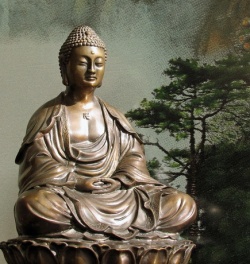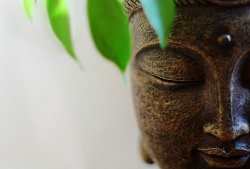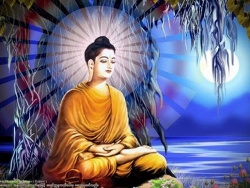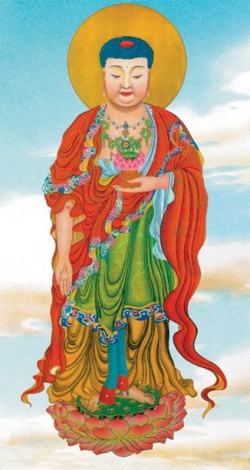The Dhyana-Samadhi Meditation Absorptions - Part 9
Shakyamuni's Experience with the Samadhi of Neither Thought nor No-Thought
While Shakyamuni took three years to attain the state of no-thought, he took another three years to attain the samadhi of neither thought nor no-thought.
But after he mastered this high stage, he knew it was not enlightenment, either. The attainment level of the samadhi of neither thought nor no-thought still belongs to the Formless Realm, and thus it is still within the skandha of consciousness.
Being within the domain of consciousness means that if you cultivate properly you can have this attainment, but you will never reach it if you do not cultivate towards it. The fact that it can disappear and no longer be there means it is a phenomenal realm, and so it cannot be the ultimate state. The Real is always and ever-present, it cannot come or go, and so the Real cannot be any type of artificial construction or function of spiritual practice. It must always be genuinely there, and through cultivation practice you just finally awaken to recognize it. That is why we say you "awaken to it." You become enlightened to that original enlightenment that was always there and ever will be there, and thus, it is not a stage of attainment you can create.
Therefore, after achieving all these states, Shakyamuni ultimately abandoned all these advanced meditation realms that people claimed were the absolute stages of salvation because he realized they can all disappear. They were not the fundamental substrate. They were not the fundamental substance or essence we call God or enlightenment or Tao or Brahma or whatever. Since they are all transient states, they are not that ultimate thing--that never changing ground state of being.
Relying on this strong foundation of profound cultivation attainments, Shakyamuni Buddha further applied himself to many other cultivation practices, including six years of extreme ascetic practices in searching for the Tao. It is because he went through all these various attainment levels and practices, which he investigated thoroughly and mastered through and through, that we can use him as our reference for today when on the path of spiritual seeking. It is because of Shakyamuni's complete efforts that we can take his teachings as a guide to our own efforts. In light of Shakyamuni's own efforts, it is laughable to review the number of individuals who presently claim they are enlightened or know the proper way to spiritual salvation when they have not even mastered the first dhyana!
To summarize, we can say that the four dhyana are still involved with the chi and mai as well as form and sensation, and thus they still belong to the skandhas of form and sensation. Many sadhus, monks and sages today reach various meditation realms within the first four skandhas, especially the lowest skandha of form, and mistakenly believe they have reached the ultimate, which they call "nirvikalpa samadhi." It is hard to convince them of their error, which is partly due to strong egos, and partly due to the pollution of views.
No matter what their level of attainment, they think "I am right and you are wrong and I cannot possibly be mistaken; what do you possibly know?" Just witness the stories of many talented worthies in the Zen school who thought they had reached enlightenment upon some lower rung of attainment, and you will realize this often happens. Without a good teacher, it is really hard to correctly climb the spiritual ladder all the way to the end.
On the other hand, some people are more honest with themselves when reaching an incomplete stage of attainment in that they know it, but then they become self-satisfied and complacent in their subsequent spiritual practice, anyway. Since they do not strive further, most never reach a modicum of true enlightenment. In fact, many do not reach enlightenment simply because they lack good teachers, or because it is a very difficult task requiring devoted practice and extraordinary merit. Sometimes their lack of attainment is simply because they lack these relevant teachings.
Looking at the various masters such as the Indians Ramakrishna, Yogananda and Muktananda, we can find these practitioners all attained various realms of samadhi, a degree of kung-fu, and sometimes a bit of prajna wisdom, but not one attained enlightenment. People like to refer to the Chinese monks Hsu Yun and the lesser Han Shan as enlightened, since they were familiar with emptiness and had attained a bit of prajna wisdom, but these monks did not attain the true stage of enlightenment, either.
In the West you find people like Rudolf Steiner and Edgar Cayce who had psychic (clairvoyant) abilities, but they lacked the orthodox samadhi attainments entirely, and were certainly ignorant of prajna wisdom and emptiness. Then you have individuals like Meister Eckhart and Padre Pio who never reached enlightened, either, but only achieved various stages of dhyana attainment. The same goes for countless Biblical prophets; while many indeed attained some degree of samadhi, none had achieved enlightenment.
You also have the founders of various modern religions, spiritual sects or spiritual movements who totally lacked any type of samadhi spiritual attainments, and there are even various groups which try to "elect" individuals into sainthood, which amounts to the mistaken belief that you can actually elect someone into samadhi. Sagehood, as you know, depends upon personal spiritual awakening--it is not attained from another or attained by decree. If people remain deluded, then they remain ordinary humans; if they awaken, then and only then do they become saints and sages, and an election has nothing to do with the process. What does an election into sainthood, which is sometimes a political decision, have to do with this process at all? We could go on and on, but these examples are sufficient to show that attaining enlightenment is not an easy feat, and people have many mistaken notions on the matter.
If your chi mai does not open, you certainly cannot achieve the four dhyana. But if your chi mai all open, can you call it enlightenment? If you open all your chakras, is this the meaning of Tao? The answer to both questions is "no," for these feats rank at the very lowest stages of spiritual attainment, and they do not even equate with seeing the path! Even if you can achieve every dhyana and samadhi, Shakyamuni warned that this is not yet enlightenment because you can still attach to false thought and take it to be what is real. Self-realization is not that simple, for you have to overturn or purify even the skandha of consciousness.
Some people curb their egos and do not go so far as to claim they are enlightened, but they still go around claiming much higher attainments than they actually have. For instance, many think they have attained various dhyana when their chi has become temporarily full because of the good health resulting from spiritual cultivation. Sometimes they even mistake this minor accomplishment, which is not even free of the skandha of form, as the samadhi of infinite consciousness or samadhi of infinite space! It may sound silly after reading all this, but you would be surprised at the number of people who take some small experience and blow it out of proportion.
There are even those who, in reaching the samadhi of infinite consciousness, actually believe they have broken through the skandha of consciousness, so there are many ways by which you can go wrong with your notions. That is why you most often need an enlightened master to guide you on the cultivation path.
For instance, when the novice Japanese Zen monk Hakuin was just beginning to make progress in his cultivation, he attained an initial experience of emptiness that was actually just a minor experiential realm. It was just a minor opening of the sixth consciousness. However, Hakuin firmly believed that his experience was unique in the world, and that no one had ever experienced a stage as high as his, and that he had broken through to ultimate attainment. As he recalled, "My pride rose up like a mighty mountain and my arrogance swelled like a tidal wave." This experience is typical of most practitioners. Even Han Shan was confused at his first little bit of attainment.
Luckily, Hakuin's teacher, Master Dokyo, refused to confirm Hakuin's experience as the Tao, and Hakuin never received any approval from his master for the many other such experiential realms he encountered, one after the other. Each time he made some little progress he repeated the exact same pattern of believing he had broken through to final attainment, and each time his master kept calling him a "poor cave dwelling devil" for making such errors. Thus, a spiritual master is often necessary to prevent you from making such presumptuous mistakes. When we look around us at all the people claiming they are enlightened in order to cheat others, or because they are cheating themselves, we just hang our own heads in sorrow.
When Zen master Hsueh-tou Ch'in was still cultivating, his attitude was a little better than most people for he reached a realm "where everything before my eyes was completely exposed and totally silent and still. For more than half a month, no signs of motion arose." Ch'in later lamented that he did not meet a master with an enlightened eye and skillful technique to break up this realm for him, for he recognized the truth to the saying, "If you do not get free of your perception of truth, it blocks correct perception."
Shakyamuni talked about a variety of possible errors you can make when you reach the higher stages of cultivation, errors that he called the fifty mara demons of delusion. Those deviant paths will certainly appear to tempt you if your attainment reaches high enough. Jesus was tempted, Buddha was tested, Tsogyel was tested, Milarepa was tested ... everyone who sincerely cultivates will be prompted to go down false paths, or succumb to self-deception.
Therefore, we should remember what Shakyamuni told his student Ananda, "Right at this moment, even if you attain the nine samadhi, you still will not end defilements (achieve the extinction of outflows) or achieve the fruits of the Arhats." These states are only the shadow of enlightenment for they still belong to the dust of consciousness. Despite their inconceivable nature, they are not the fruit of self-realization.
The various samadhi are all based on consciousness, meaning they are not the truth itself but just the shadow of the truth. And so, even though they represent an extremely high stage of spiritual achievement, they are just another way for you to deceive yourself if you are not careful. They are simply practice vehicles that help train you, that help you purify your mind so that you might one day see the Tao. However, they are not the Tao itself even though they may be formless stages of attainment.
People who tread the path to enlightenment must always be careful of the deviant paths which veer away from Tao because those who take particular, discrete stages as their cultivation targets (such as specific levels of kung-fu or superpowers), instead of pursing their fundamental essence, end up wasting their time and deviating from the great matter.
It bears repeating why the Zen masters have never followed the approach of progressively leading one through kung-fu and samadhi bit-by-bit, as you might find in India or Tibet, and as we saw with the story of Gampopa. Rather, they have always pointed directly towards bodhi, which is the pure enlightenment mind. The Zen school has always emphasized the imageless attainment of the prajna transcendental wisdom and on this path, a Zen practitioner must pay no attention to the various experiential realms that arise. After all, experiential realms (samaya) are like the weather and the weather, good or bad, always passes. Phenomena will change, the weather will change, and these experiential realms will pass away, so they cannot be considered the ultimate foundational nature that we are seeking.
On the other hand, the Zen masters have also said that attaining bodhi is seeing only the beautiful side of the matter, and is not the whole thing, either. There is also the realm of existence to be understood and mastered. Therefore, you still need to understand all nine samadhi of cultivation, only after which you can say you have finished the whole course and understand both sides of the matter. And not only must you attain the Tao, but in addition to realizing the dharmakaya, you must cultivate the sambhogakaya and nirmanakaya as well.
THE SAMADHI OF EXTINCTION
The ninth samadhi is the attainment stage of the great Arhats, or the Arhat's stage of extinction. It is sometimes called the "nirvana with remainder" (remaining dependency) because it is the highest possible samadhi in the Formless Realm for those who are not Buddhas or Bodhisattvas.
When a great Arhat dies, he or she can show you eighteen different transformations of their body, and even burn it into ashes so that nothing is left. When they are about to leave this world for good, the Arhats sometimes perform this type of miraculous display, which has given rise to the saying, "They reduce their bodies to ashes and extinguish their knowledge."
As an example, Buddha's cousin Ananda reached the stage of an Arhat and at the age of one hundred and twenty, knew he was about to pass away. The kings of two states heard that he would soon die, and hurried to bid him farewell. Knowing that each side would wish to claim his funeral relics, and wishing to prevent any possible disputes, Ananda used his superpowers to raise his body into the air and let it be consumed by the fire element so that both countries could share in his relics (sariras). To encourage faith in the path, this is something the Arhats typically do.
Other people can sometimes demonstrate the same transformations that an Arhat can do even though they have not yet achieved this stage of attainment, so you should not jump to conclusions and believe someone is a great Arhat just because they can exhibit similar feats. In fact, we can say there are two kinds of Arhats. Some Arhats will not even have the same superpower abilities as other Arhats, who do choose to cultivate them, because they only focus on prajna wisdom in their cultivation and do not go out of their way to cultivate the physical supernormal abilities. Of course, a genuine Arhat will have the normal cultivation kung-fu and the attendant superpowers that go along with his or her stage of attainment, but not necessarily those powers that represent the great transformational abilities of the basis.
Let's put it this way. Even if you attain enlightenment, you will not immediately have the ability to fly through the air or walk through walls unless you can also transform your physical body, which is why you must achieve the sambhogakaya and nirmanakaya bodies in addition to the dharmakaya. With great wisdom you can see the dharmakaya and awaken, but your physical nature still needs time to undergo transformation. Some Arhats just cultivate wisdom rather than their physical nature, and so they may lack the ability to display various physical superpowers. They will just be able to remain clear in all situations, let go of their old habits, and not be tied down by name or fortune, but their clarity of emptiness, prajna and seeing the world as an illusion will not necessarily produce the kung-fu of supernormal physical abilities unless they so cultivate them.
As you can thus, surmise, it becomes very difficult to judge someone's stage of cultivation attainment from just the outward display of the paranormal phenomena they can demonstrate. That is why we have the stories of various Hindu and Tibetan masters challenging one another, for the ignorant master with lower achievements usually knew nothing of the superior one's sublime achievements. Because of ego and pride, which demonstrates their inferior status, they challenged their betters, whom they perceived as lacking superpowers altogether. For instance, when the Taoist Immortal Lu Ch'un-yang met the enlightened Zen master Huang-lung Nan, he could not tell that the master was anything other than an ordinary monk!
In general, human beings are most impressed by tales of siddhi powers and external kung-fu, and totally ignore the invisible but much higher accomplishment of prajna wisdom. In making the mistake of judging only what they can see, humans end up grouping the high with the low and the low with the high. Thus, it is said that a second degree Bodhisattva understands all the kung-fu of a first degree Bodhisattva, but the first degree Bodhisattva can understand little about the cultivation stages of those higher than himself.
In general, the higher always understand the lower, but the lower have no comprehension of the higher until they actually reach that stage. This is not surprising. If we look at children, we can say that they certainly do not understand their parents. And yet when they reach adulthood, as mature individuals they finally realize what their parents were talking about and why they acted the way they did. As they get older they pass through all these stages of maturity that their parents passed through, but before that time, they cannot understand them.
If we go back to those who can perform the eighteen transformations of an Arhat, it is a definite fact that their chi mai must already be open for them to be able to control the fire element of the body. But now an important question arises: if you open up all your chi mai, will you necessarily have superpowers like this? No, not necessarily.
As we mentioned, some great Arhats practice to get superpowers and so obtain them, while others practice for prajna wisdom and, due to their lack of efforts, do not obtain any such superpowers at all. You can cultivate just transcendental wisdom, or wisdom and phenomena. Thus, there are two types of cases even for this advanced state. This is how difficult it is to judge matters from the external perspective, which is why behavior and transcendental wisdom are proper measuring sticks for attainment.
With this in mind, you can see how it is hard for the public to distinguish between great men like Confucius, who never exhibited any superpowers at all, and adepts like Milarepa, who exhibited supernatural transformations in abundance. We cannot say for sure that Confucius did not attain superpowers through his cultivation, for he might have attained them and refused to use them out of discipline. After all, Confucius knew of the world of ghosts and spirits, but refused to talk of spiritual beings and unnatural phenomena. In fact, when one of his students asked how we should serve the spirits of the dead and spirits of heaven, Confucius rebuked him by replying, "You cannot even serve humans, so how can you serve the spirits?" If you are trying to establish a spiritual path for humanity, it is best to leave such topics alone.
Confucius said this because his goal was to teach people what it really meant to be human in the world, and this certainly does not involve superpowers and the paranormal. For his message and goal, to talk about siddhis would have muddled and polluted this great deed. Therefore, Confucius did not teach the path of cultivating chi channels and chakras and samadhi, but taught the path of virtue, behavior and knowing the mind as a means to Tao. As to Milarepa, we know that he cultivated his body greatly, and so his superpowers were quite strong.
The Confucian Wang Yang-Ming wrote that he himself developed various superpowers and played with them for awhile, but he later discarded this fascination after he realized this path was useless and did not amount to much of anything. There is evidence from Plato's dialogues that Socrates had also attained superpowers, such as being able to foretell the future, but he also practiced restraint in their use. Like Confucius, he taught what it meant to be human in the world, and paranormal abilities play no part in this sort of discussion. Wisdom and behavior are much more important. So as can be seen, it gets very tricky in ranking people and their stage of cultivation accomplishments.
Nevertheless, when Arhats are ready to leave this world, it is common for them to display their superpowers that they may have kept hidden throughout their lives. It is at this point that they rise into the air and demonstrate these various transformations, saying something along the lines of,
My life in this world is over.
My practice and conduct have been established.
My task is done, I have paid off all my karmic debts.
I will never need come back again.
In actuality, we cannot say the Arhats have entirely escaped the Three Realms of Desire, Form, and Formlessness because their cultivation has only earned them a very long respite from the cycle of transmigration. They have reached a stage of selflessness, but they have not freed themselves from the pull of transmigration entirely.
After an extraordinary large number of kalpas, indicated by the symbolic number of 84,000 eons, they will use up their merit and will need to return to the lower realms to start cultivating again. Thus, we can only consider their escape a type of very long vacation. Time means nothing in the ultimate sense, since it is relative in the various realms of existence, so we cannot really say this is a "long" vacation either. In one sense, you can say that it is over in the time of a finger snap, or from the standpoint of the Tao, conventional existence is no existence at all.
Even the Bodhisattvas cannot escape the Three Realms, for there is no other Fourth Realm where they can go. You can only learn how to control the process of transmigration, and choose where you are going to go and what you are going to do next within the Three Realms. That is why Bodhisattvas make their vows and then continue to go about exercising their enlightened functioning in the world.
For instance, many Bodhisattvas continue returning to our lower realm, rather than stay in the more pleasant heavens, to help banish suffering in our world through transmitting spiritual teachings that will lead people onwards to spiritual liberation and enlightenment. Thus, they return to our painful world of suffering to help us while cultivating ever increasing levels of prajna wisdom, merit, and skillful means. Since there is no way to escape the Three Realms, and no security for even the tiniest moment, they spend their time working to master skillful deeds throughout the Desire, Form and Formlessness Realms. They continually work on purifying all their behavioral seeds while helping to liberate others and mastering all sorts of excellences. This is how they express the enlightened functioning of the Tao.
The Zen school says the Arhats, in their desire to escape the world, only focus on one side of the matter--the emptiness side of Tao. In their cultivation, they still hold onto the view of emptiness so strongly that they miss the fact that emptiness can give rise to the wondrous side of existence, and they shun conventional reality. While their attainment stage is a nirvana, it is called "nirvana with remainder" because it is not the pure nirvana of the Buddhas, which has totally finished with the control of birth and death.
We therefore say that the nirvana realm of the Arhats is "fractional" because it lacks the immeasurable purity and totality of inconceivable merit that accompanies the nirvana realm of the Buddhas. The Arhats at this stage still retain the extremely subtle habit of clinging to emptiness, and this is their "remainder." It represents subtle tendencies, subtle habits of clinging that they have not yet gotten rid of. Therefore it is an imperfection to the complete cultivation of the Tao.
Since Arhats lack the highest merit of complete enlightenment, they still retain subtle defilements that will eventually require their rebirth. On the other hand, even though the Buddhas have finished with birth and death, out of choice they keep entering the world of form to save beings and eliminate their sufferings instead of taking long vacations in pleasant realms. This, of course, is what makes them Buddhas rather than Arhats who seek seclusion or who worry about only their own enlightenment.
The Buddhas not only know the emptiness aspect of Reality, but they become fully functional in the aspect of wondrous existence and do not shun it. They know the Middle Way of functioning in both realms simultaneously without abiding in either, so they are not attracted nor repelled by either extreme. Yet, since becoming involved in the Three Realms is the exercise of compassion, they enter these realms fearlessly to save as many beings as they can.
In Esoteric Buddhist practice, most people follow the Hinayana approach of cultivating to achieve the basic four dhyana and four formless samadhi. Although they may then become able to escape the Realm of Desire and achieve rebirth in the Realms of Form or Formlessness, and although they might be reincarnated in the high stage Buddha realms, the most we can say is that they have escaped from this world.
The Zen school calls these adepts "half-baked" because while they have escaped from this world to dwell in higher planes of existence, they have not achieved the whole dharma. Thus, they are only "half done," from which comes the terms "half-baked," "fractional," or "with remainder." When they finally cultivate their wisdom high enough to realize that there is nothing to separate themselves from, and therefore nothing to avoid, then we can say they have totally abandoned their delusions. Of course, after that realization and the fact that they vow to work in the realm of cyclical existence for the sake of all beings, only then will we be able to call them Bodhisattvas or Buddhas.







